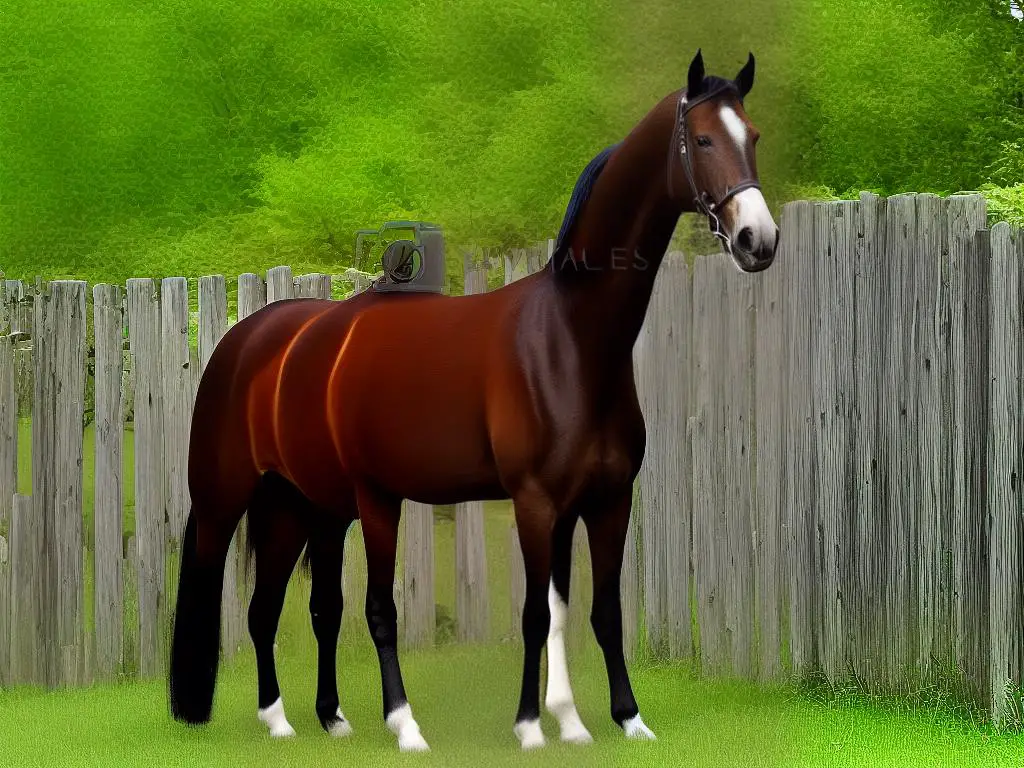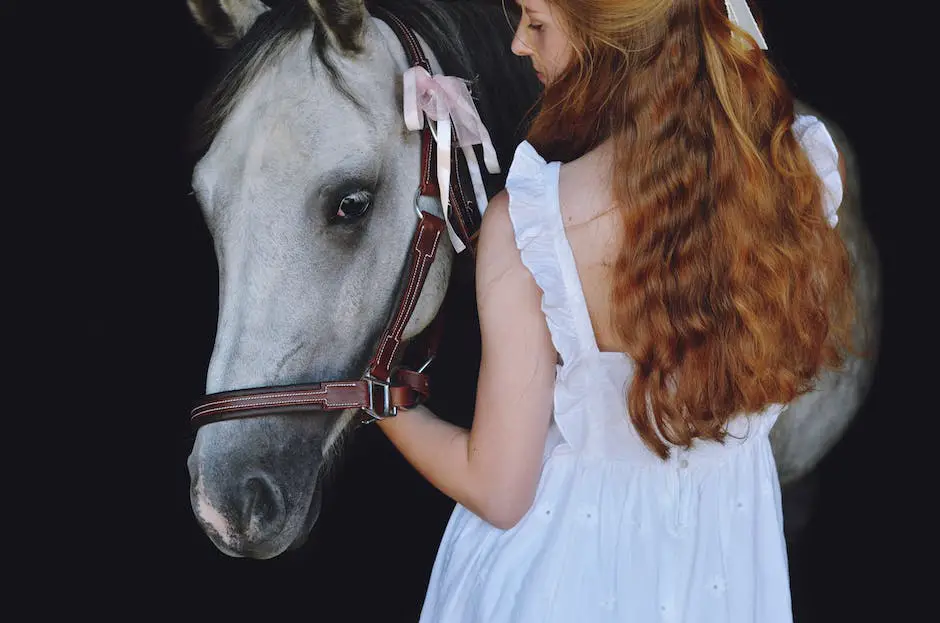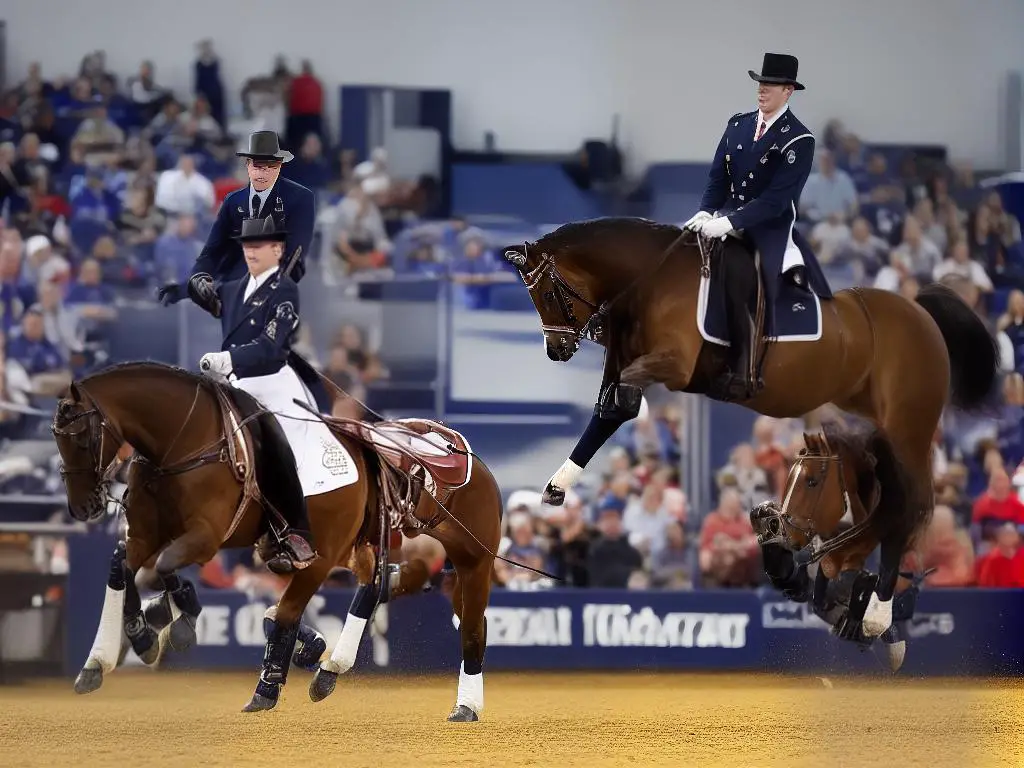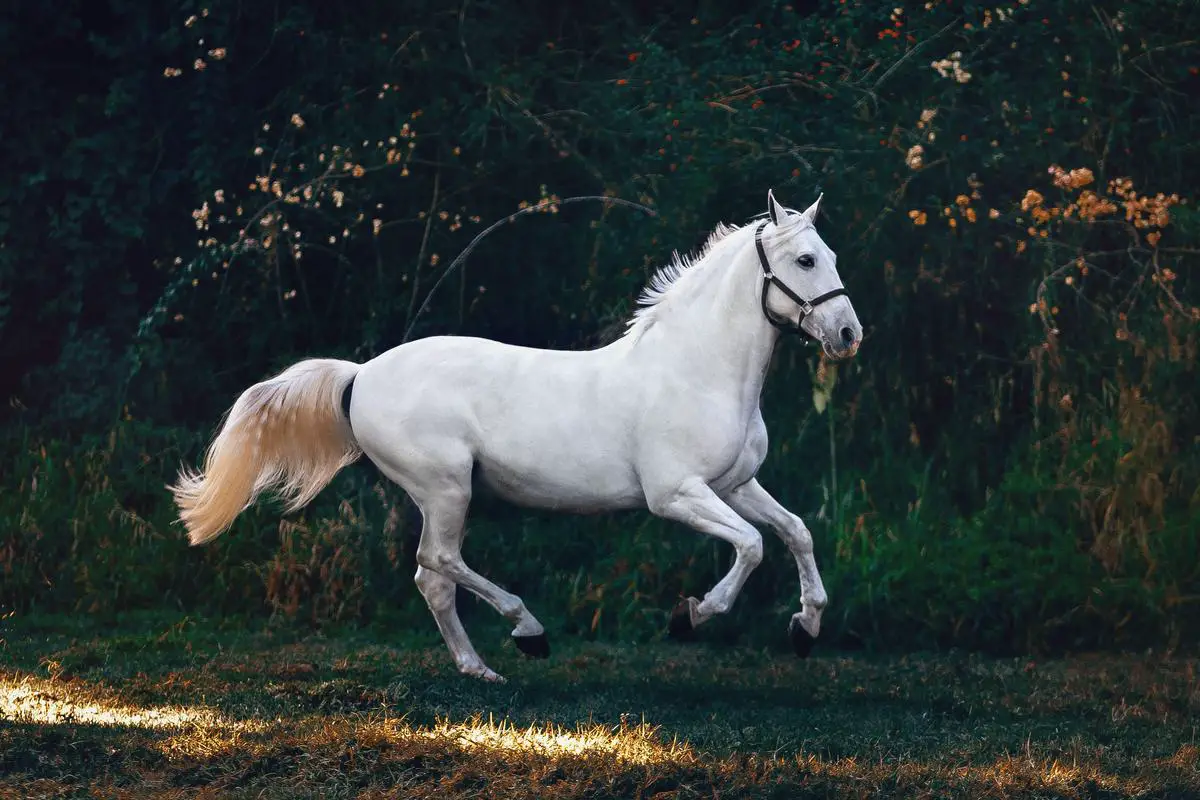Welcome to the exciting world of American Saddlebred exhibitions! In this comprehensive guide, we’ll take a closer look at the rich history, unique traits, and exceptional skills of this versatile horse breed, as well as the many training techniques and events that showcase their captivating performance abilities.
Table of Contents (Horspedia)
History of the American Saddlebred
The American Saddlebred horse breed has a rich history that traces back to the early settlers in the United States. The breed’s development was primarily driven by the need for a versatile and comfortable riding horse that could also be used for working tasks on farms. The foundation of the breed was laid during the 1700s when the Thoroughbred, Irish Hobby, and Galloway horses were crossbred with native American horses, which resulted in the Narragansett Pacer. In the early 1800s, the American Saddlebred began to take shape with the influence of the Morgan horse and other European breeds, including the Hackney and Arabian. Over the years, American Saddlebeds have become known for their elegant appearance, smooth gaits, and exceptional athletic abilities.Throughout history, there have been many notable American Saddlebred horses and influential breeders that have contributed to shaping the breed. Denmark F.S., foaled in 1839, is considered the foundation sire of the American Saddlebred. Over the years, significant horses such as Chief Pottawatomie, Peavine, and Montrose contributed to refining the breed’s traits. Breeders like J. Bacon, John Walls, and Charles F. Wall played a crucial role in the expansion of the breed across the nation. During the period after the Civil War, the American Saddlebred gained prominence throughout the South, where it became known for its exceptional performance in horse shows and exhibitions.The American Saddlebred has been a popular breed for exhibitions since the late 19th century when horse shows started to gain traction in the United States. The breed’s smooth gaits, particularly the slow-gait and rack, made it an ideal choice for performance, with riders displaying their horse’s skill and athleticism in various classes. The first American Saddlebred Horse Association National Futurity was held in 1923, promoting the breeding of top-quality American Saddlebred horses. Today, the World Championship Horse Show, held annually at the Kentucky State Fair, is one of the most prestigious exhibitions for these graceful animals, showcasing their abilities in various disciplines, including saddle seat, driving, and fine harness.

Breed Characteristics
The captivating presence of the American Saddlebred can be attributed to their striking physical features, combining both grace and athleticism. Their elegant neck, long, arched, and muscular, allows them to hold their head high with ease and poise, undoubtedly commanding attention and admiration in American Saddlebred exhibitions.
Their bodies are refined yet powerful, with a deep chest, strong back, and well-sprung ribs. This robust build enables them to excel in a variety of disciplines, from saddle seat and driving classes to dressage and jumping competitions, reflecting their versatile nature and making them a breed beloved by enthusiasts and hobbyists alike.
In addition to their impressive physique, the American Saddlebred’s disposition contributes significantly to their exceptional performance in exhibitions. Known for their intelligence and strong desire to please, these horses easily grasp new concepts and develop a deep bond with their riders and trainers. According to enthusiasts, American Saddlebreds tend to possess a showy, animated, and resilient temperament—qualities that make them natural show horses.
This breed exhibits tremendous energy and is often described as “forward-moving,” giving their gait a uniquely smooth and fluid appearance.
One of the outstanding traits of the American Saddlebred is their remarkable versatility, which distinguishes them from other breeds and contributes to their success in American Saddlebred exhibitions. These horses can be trained in a range of gaits, such as the walk, trot, canter, slow gait, and the swift yet graceful “rack.” This ability to perform five distinct gaits is known as “Five-Gaited,” while those mastering only the standard three gaits are referred to as “Three-Gaited.” Their proficiency in mastering various gaits and transitions demonstrates their innate athleticism and intelligence, making them an exceptional choice for riders interested in participating in a diverse array of disciplines.

Training and Conditioning
Meticulous training and conditioning are vital in preparing American Saddlebred horses for exhibition events. Employing a variety of training techniques, equipment, and exercises is crucial for proper conditioning while ensuring the horse’s well-being. Recognizing each horse’s unique characteristics is essential, as this insight enables trainers to create individualized programs tailored to enhancing the horse’s gait, stamina, and balance. For American Saddlebreds, the most esteemed gaits include the Walk, Trot, Canter, and the specialty gaits Slow Gait and Rack.
Training sessions should be consistent and gradually increase in intensity, helping the horse develop the necessary muscle strength while minimizing the risk of injuries. With the right approach, American Saddlebred horses can excel in various disciplines and bring pride to riders and trainers at exhibitions.
There is an array of training equipment that facilitates the development of American Saddlebred horses for exhibition events.
These include long-lines, surcingle, tack, and various types of lunging equipment.
Additionally, trainers use protective boots and wraps to prevent any leg injuries during the training sessions.
Surcingle and long-lines are particularly helpful for groundwork and help the horse learn to balance, flex, and carry themselves correctly.
Moreover, trainers often use different bits and bridles suited for the unique needs of each horse, allowing for better communication and control.
Incorporating stretching exercises, cavaletti work, and hill or trail riding further supports the horse’s conditioning process as these activities enhance flexibility, strength, and overall fitness.
One of the crucial aspects of training American Saddlebred horses for exhibition events is monitoring and maintaining their health.
Horses should be provided with a properly balanced diet and be regularly examined to ensure they are physically and mentally fit for the training demands and exhibition events.
Adequate warm-up and cool-down periods are essential during each training session as they help prevent injuries, reduce muscle soreness, and keep the horse comfortable.
It is also necessary to educate riders and trainers on relevant precautionary measures relating to the horse’s care, such as avoiding overworking or pushing the horse beyond its physical capabilities.
Ultimately, a properly trained and conditioned American Saddlebred horse will be well-prepared for thrilling and impressive performances during exhibition events.

Types of American Saddlebred Exhibitions
In the show ring, American Saddlebred horses are known for their elegance, versatility, and show-stopping performances. One popular event in which these horses participate is the breed-specific horse show. These competitions typically showcase the various divisions of the American Saddlebred, including five-gaited, three-gaited, park, pleasure, and fine harness classes. Each division has specific requirements and judging criteria, focusing on the horse’s performance, manners, presence, and overall quality.
The performance classes are further divided by age and skill levels of both the horses and riders, allowing for a wide range of opportunities for enthusiasts and hobbyists, like yourself, to participate and test their skills in the show ring. By following the aforementioned health and training guidelines, you will be better equipped to excel in these competitions and showcase the true potential of a well-trained American Saddlebred horse.
In addition to breed-specific shows, American Saddlebred horses are often showcased in open and all-breed competitions. These events offer a more diverse range of classes and disciplines, where Saddlebred horses can compete against other breeds in areas such as western pleasure, trail, and equitation. While the judging criteria may vary depending on the event and specific class, the American Saddlebred’s athleticism, beauty, and responsiveness often make them an eye-catching competitor.
As an enthusiast or hobbyist, participating in parades and demonstrations can be an exciting way to share your passion for American Saddlebreds with the public. These events range from small, local exhibitions to larger, nationally recognized events such as the Kentucky Derby Parade. The demonstration and exhibition teams showcase the American Saddlebred’s versatility through intricate routines, choreography, and the breed’s distinctive high-stepping gait and charismatic presence. Performances like these not only celebrate the horse’s achievements in the show ring, but also educate and entertain spectators about the incredible qualities of the American Saddlebred breed.

Preparing for a Saddlebred Exhibition
Commitment and attention to detail are crucial in preparing an American Saddlebred for exhibition, ensuring both horse and rider are primed for a seamless performance. It begins with consistent, focused training designed for the specific classes in which you plan to compete, such as three or five-gaited, fine harness, or pleasure events. Regular grooming – which includes clipping, bathing, and mane and tail care – along with proper nutrition and exercise will contribute to the horse’s overall health and appearance. Familiarizing yourself with American Saddlebred Horse Association (ASHA) rules and regulations will help you remain compliant and ensure a smooth exhibition experience. Moreover, investing in riding lessons from experienced trainers will significantly improve your riding and exhibiting skills, making you an accomplished participant in American Saddlebred exhibitions.
Proper attire and equipment for both horse and rider are essential for a successful Saddlebred exhibition. Riders must adhere to strict clothing guidelines that vary by class, but often include a conservative suit or jacket, jodhpurs, dress boots, a show shirt, gloves, and a riding helmet that conforms to safety standards. Traditional saddle seat attire is typically black or navy blue. For the horse, proper tack includes an English-style bridle, a saddle seat saddle, a girth or breastcollar, and a saddle pad corresponding to the specific event. It is vital to ensure that all tack and equipment is properly sized and adjusted for the horse’s comfort and safety.
Diving into the world of American Saddlebred exhibitions begins with scouting out the competition and attending various shows to gain a better understanding of judging criteria and the methods employed by successful exhibitors. Observing others in action allows you to learn about class-specific guidelines, trends, and styles, while networking with fellow enthusiasts provides valuable insight and camaraderie. Remain connected to local and national organizations, as well as American Saddlebred publications, to keep informed on industry news and upcoming events. Building relationships with mentors and experienced exhibitors paves the way for first-hand guidance and support as you navigate the fascinating realm of American Saddlebred exhibitions.

Rules and Regulations
As you immerse yourself deeper into American Saddlebred exhibitions, it is essential to thoroughly understand the rules and regulations that govern these events. This knowledge ensures that the integrity of the sport is upheld, and the wellbeing of both riders and horses involved is maintained. By establishing a strong foundation in understanding the guidelines, you will be better prepared to participate in exhibitions while exhibiting high standards of respect and sportsmanship for fellow competitors, judges, and, most importantly, the American Saddlebred horses themselves.
One of the primary organizations responsible for overseeing these events is the American Saddlebred Horse Association (ASHA).The ASHA aims to promote the breed and establish guidelines for ethical practices in competitions.To that end, the ASHA has compiled a comprehensive rulebook that participants must strictly adhere to while competing in the sport.This rulebook encompasses topics such as equipment, attire, horse care, and judging criteria for various classes and disciplines within the American Saddlebred world.One key aspect of the rules and regulations for American Saddlebred exhibitions is the welfare of the horse, which is always a top priority.The ASHA prohibits any inhumane treatment of the animals, such as soring, which is a process that involves intentionally causing pain to the horse’s legs in order to create a “high stepping” gait.Additionally, riders and trainers are expected to demonstrate good sportsmanship and ethical behavior.Any instances of abuse or unsportsmanlike conduct can lead to disqualification or suspension from the sport.Moreover, the ASHA strongly enforces strict guidelines for the use of medications and supplements, as well as ensuring accurate record-keeping for all horses competing in the events.When it comes to the actual competitions, riders must adhere to specific guidelines in terms of their attire, which must be traditional and suitable for their chosen discipline.For example, riders in saddle seat events must wear a conservative suit or habit, jodhpur boots, and a derby or soft hat.Furthermore, judges at American Saddlebred exhibitions follow a defined set of criteria when evaluating performances.Each class or discipline has its own unique set of standards and expectations, some of which include quality of the horse’s gait, the harmony between rider and horse, and the overall presentation of the entry.
By familiarizing oneself with the rules and regulations of American Saddlebred exhibitions, enthusiasts and hobbyists alike can work towards becoming skilled in this competitive environment and ultimately contribute to the breed’s overall promotion and support. Understanding the intricacies of these competitions will enable individuals to better appreciate and showcase the remarkable attributes of the American Saddlebred breed.

Promoting and Supporting the American Saddlebred
To further elevate the presence of American Saddlebreds in the equestrian world, it is crucial to develop strong advocacy efforts and foster relationships with prominent figures in the industry. By dedicating time and resources to building these vital connections, enthusiasts can help to create a larger, more informed audience for this magnificent breed. Collaboration with other organizations and individuals in the equine industry, such as trainers, veterinarians, breeders, and other key stakeholders, can lead to mutually beneficial partnerships that bolster the American Saddlebred’s presence in notable exhibitions.
Sponsorship plays a critical role in promoting the American Saddlebred and its continuous success in exhibitions. By identifying and establishing relationships with local businesses and organizations interested in supporting the breed, enthusiasts can secure financial assistance necessary to compete in prestigious events, undertake marketing campaigns to attract public interest, and even develop activities to engage the community and raise awareness about the breed. When local businesses and organizations support the breed, it creates an environment that fosters an appreciation of the breed amongst businesses and the general public alike.
To further cultivate a thriving American Saddlebred community, networking and community involvement are essential components. Engaging in community events and partnering with local horse clubs, schools, and non-profit organizations can create a sense of camaraderie around the breed and encourage local support. These cooperative efforts not only facilitate knowledge sharing and generate awareness about the breed but also open up potential avenues to recruit future American Saddlebred enthusiasts committed to the breed’s long-lasting exhibition success.

Photo by wildlittlethingsphoto on Unsplash
As you progress on your journey to becoming skilled in the realm of American Saddlebred exhibitions, remember that enthusiasm, dedication, and continuous learning are key factors to success. By embracing the diverse aspects of this magnificent breed and becoming actively involved in the community, you’ll not only make valuable connections but also help promote and support the American Saddlebred’s enduring legacy in equestrian exhibitions. Best of luck, and happy riding!
